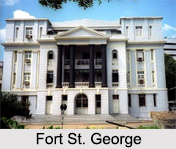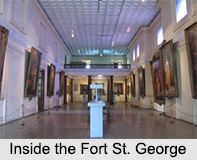 Fort St. George is the first British fortress in India which was constructed in 1638 in the coastal city of Chennai. The construction of the fort was planned for further settlements and trading activity in an uninhabited land. This fortress is one of the most popular tourist spots in Chennai. In recent years, the fort has served as the administrative building of Government of Tamil Nadu. The Legislature of Tamil Nadu and secretariat were located in the fort till 2010.
Fort St. George is the first British fortress in India which was constructed in 1638 in the coastal city of Chennai. The construction of the fort was planned for further settlements and trading activity in an uninhabited land. This fortress is one of the most popular tourist spots in Chennai. In recent years, the fort has served as the administrative building of Government of Tamil Nadu. The Legislature of Tamil Nadu and secretariat were located in the fort till 2010.
History of Fort St. George
The British East India Company, which began its trade from Surat, found the necessity to create a base which would be closer to the Malaccan straight. This shall give impetus to the spice trade of the company. For this reason the company decided to construct a fort on the no man`s land which later on came to be the hub of merchant activities in Chennai. The fort was completed in April 23, 1644 which coincided with St George`s birthday, a patron saint in England. This suggested the name of the fort as Fort St. George. This sea facing fort gave birth to new settlements known as George Town. The George Town later on developed into a number of villages that developed into the city of Chennai. This small township along with its impressive fort helped the British to establish their influence over the Carnatic region and keep the French away from Arcot and Srirangapatnam. The fort was occupied by the French during 1746 to 1749 but was restored by the British under the Treaty of Aix-la- Chapelle, which ended the war of Austrian succession.
Important Buildings in Fort St. George
Fort St. George covers a huge area with 6 meters high walls that stood strongly at the face of number of assaults during the 18th century. There are certain important buildings inside the fortress and they are St. Mary"s Church, Museum, Wellesly House:
 St. Mary"s Church: The church is one of the oldest angelican churches of India. The St. Mary Church was built in 1678- 80 AD. This ancient church has been noteworthy for solemnizing the marriage of Robert Clive who later on became the Governor of Bengal and Elihu Yale, who later became the first benefactor of Yale University in the United States.
St. Mary"s Church: The church is one of the oldest angelican churches of India. The St. Mary Church was built in 1678- 80 AD. This ancient church has been noteworthy for solemnizing the marriage of Robert Clive who later on became the Governor of Bengal and Elihu Yale, who later became the first benefactor of Yale University in the United States.
?? Museum: The Fort Museum, which is the only ticketed institution of Archaeological Survey of India in the complex, exhibits many items of the period of English and later British rule. This building was completed in 1795 and first housed the office of the Madras Bank. The hall upstairs was the Public Exchange Hall and served as a place for public meetings, lottery draws and occasional entertainment. These relics are reminders of British rule in India. The objects on display in the museum are the weapons, coins, medals, uniforms and other artifacts from England, Scotland, France and India dating back to the colonial period. Original letters written by Clive and Cornwallis have been restored in this museum. One set of quaint period uniforms is displayed for viewing, as well. However, the "Piece de Resistance" is a large statue of Lord Cornwallis.
Wellesley House: The Wellesley House was occupied by Col. Wellesley. The building has an impressive banquet hall along with a number of paintings of the governor of the fort and other officials of the regime. The canons of Tipu Sultan decorate the rampart of the museum. This building is mainly used as the museum which includes different types of Statues and paintings that depict the legends of Richard Wellesley and his brother, Duke of Wellington.
Visiting Information to Fort St. George
Fort St. George is located only a kilometer away from the Chennai Railway Station and 21.9 km from Chennai International Airport. This fort can be easily reached by bus, cab, auto or private/hired car.



















